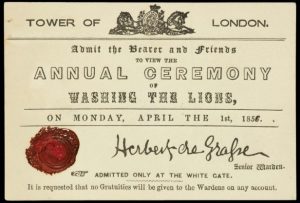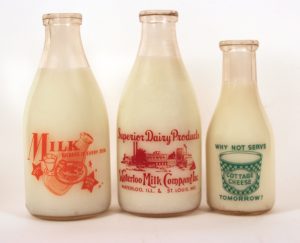The month of April is the first full month in spring, and is often associated with things like warmer weather, the start of Major League Baseball, Easter (most years), and for many people, April Fool’s Day.

The history of April Fool’s Day goes back quite a bit farther than most people probably realize. According to Wikipedia, there are references from several countries dating back centuries to days in which people would trick, or make fun of someone or something on or around the first of April. The article states that separate events in France, England, and the Netherlands all from the 16th century and earlier could be seen as the unofficial start of April Fool’s Day. A popular prank which lasted nearly two centuries in London was the “Annual Washing of the Lions” ceremony taking place on April 1st at the Tower of London. The hoax is believed to date back as far as 1698 and was still in practice by the mid 1800s, as evidenced by the ticket from 1856 to the right.
Whatever the source for this non-holiday, April Fool’s Day is alive and well with jokes and pranks appearing on the Internet with regularity from companies large and small. Google has a long history of elaborate and well written pranks that on more than one occasion have caught people off guard.
You never know when and where you’ll find an April Fool’s prank, and in the case of good ones, you don’t even realize it’s a prank right away. Usually it takes a bit of reading before you realize something is amiss.
It seems that Herb Keppler and the staff at Modern Photography were in the business of lighthearted pranks, as in this article from April 1952 the staff goes over what they call a “First in Modern’s Yearly Series of Simple, Definitive, How-to-do-it Articles” an instructional guide to making your own lens out of a milk bottle.

The article is structured like a guide that goes over the process of how to select the right bottle, who to hire to inspect the optical characteristics of the glass, what types of hardware you’ll need to cut, polish, and create the actual lens elements, and so on. My favorite part is coming up with a name for your own Milk Bottle Lens with suggestions for names like “Mootar” or “Lactar”. It’s not until the very end of the article do you get any direct hint that this article is a hoax as the final suggestion for a name is “Bulltar”!
I am sure with the right equipment, you probably could produce an optical lens from the glass of a milk bottle, but the results would hardly be worth it. In addition to the necessary optical expertise required to design such a lens, equipment like Diamond Saws, Polishing Machines, and Optical Lathes are hardly inexpensive. The article estimates that such equipment could be had for “less than $25,000” which when adjusted for inflation, is over a quarter of a million dollars today!
So while I doubt many “Milk Bottle Lenses” have ever been made, this article was likely a fun diversion from the technical and educational articles frequently appearing in Modern Photography at the time. I enjoyed reading it, and am sure you will too!
Edit: Shortly after posting this article, I received a message from a Vintage Camera Collector, Toni Nikkanen who pointed out that someone had actually done something similar to this, but instead with a beer bottle. The article is written in Finnish, so unless you speak Finnish, you’ll need to use Google Translate to understand it, but there are pictures of the process of cutting and polishing the glass and some sample images on the last page. Thanks Toni!
All scans used with permission by Marc Bergman, 2018.








Mike, the latest (June ’18) issue of Model Airplane News highlighted a 3″ x 5″ magnetic tray for people who work with small items such as R/C aircraft, cameras and so on. About $5 each.
I ordered 2 of them!
Very interesting. Thanks